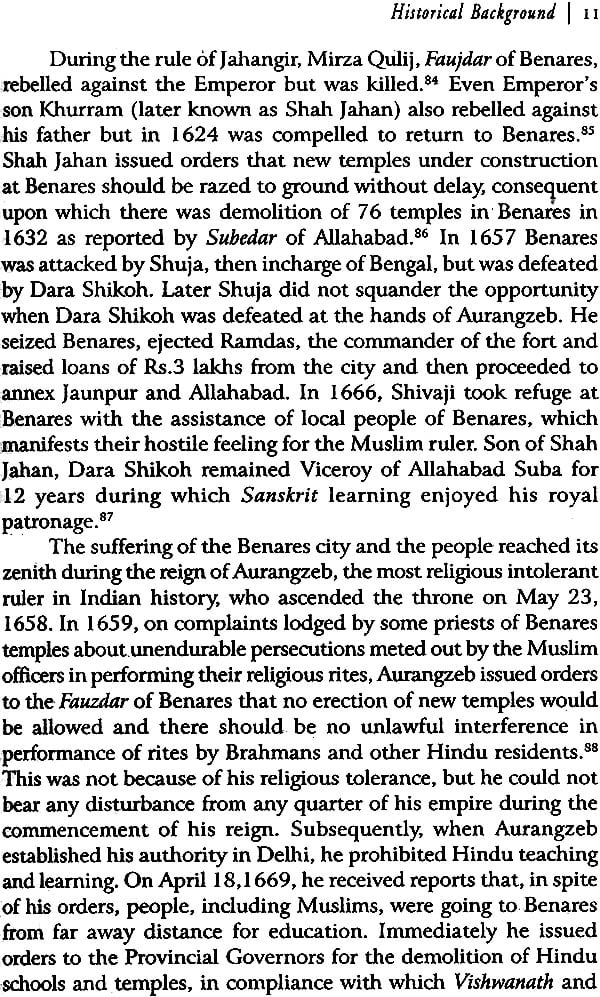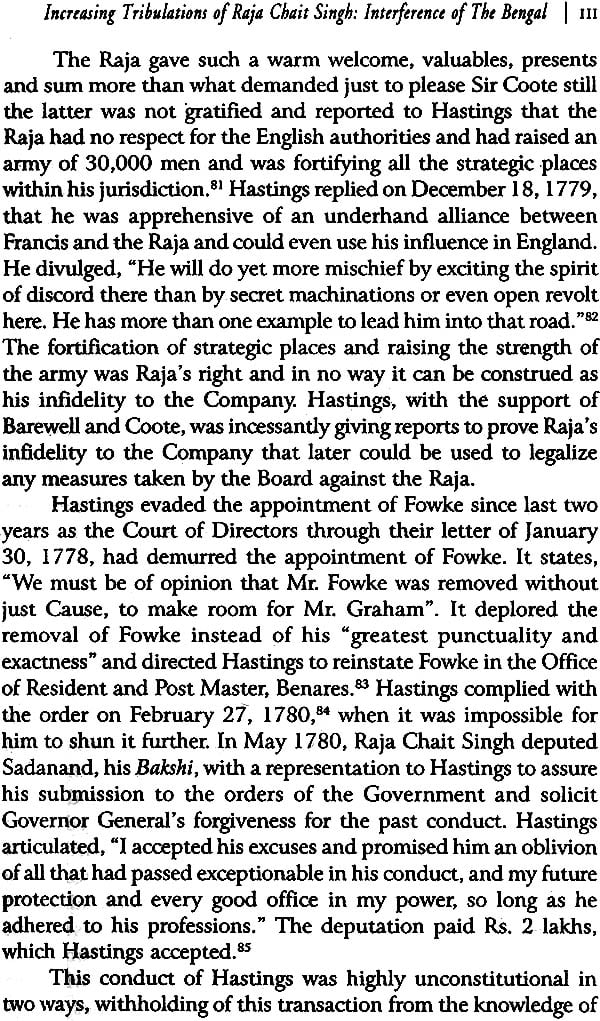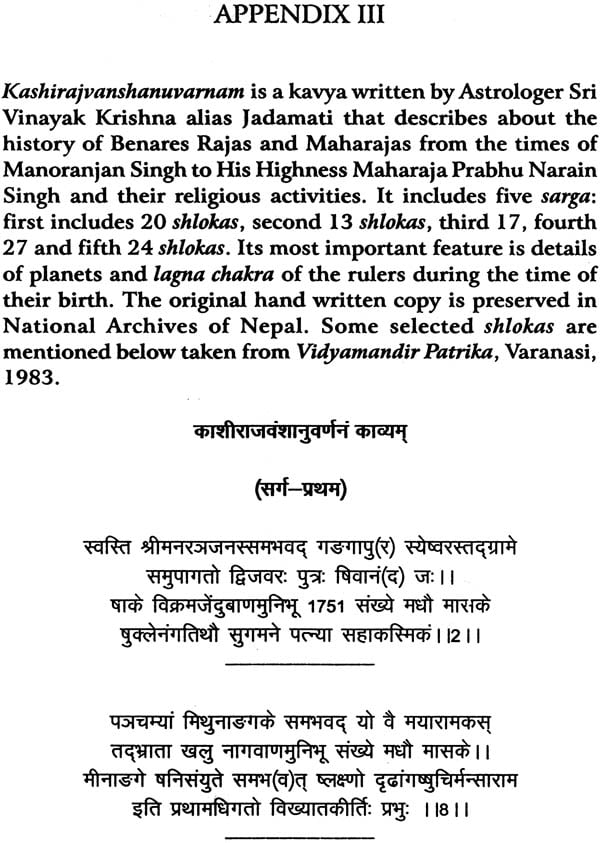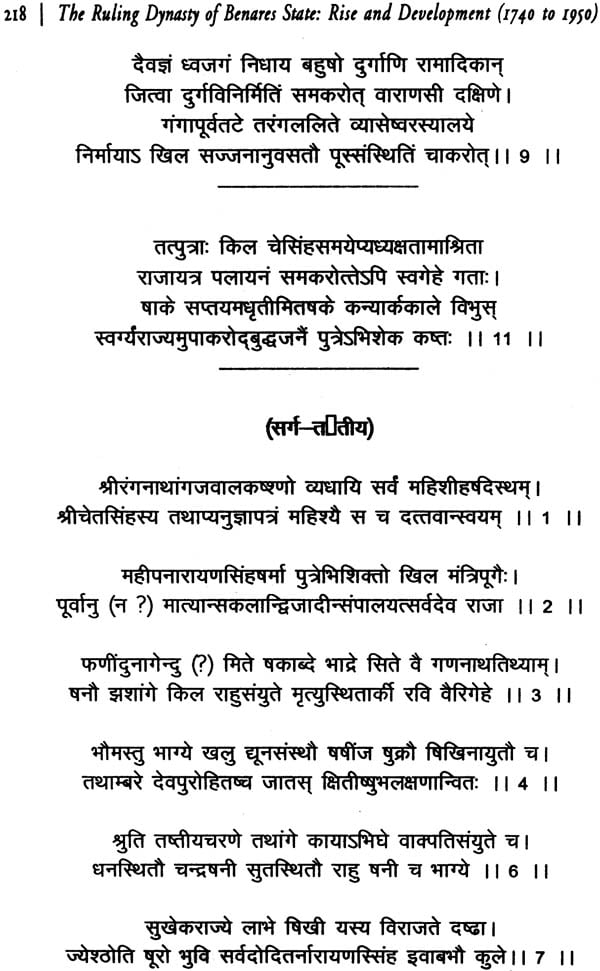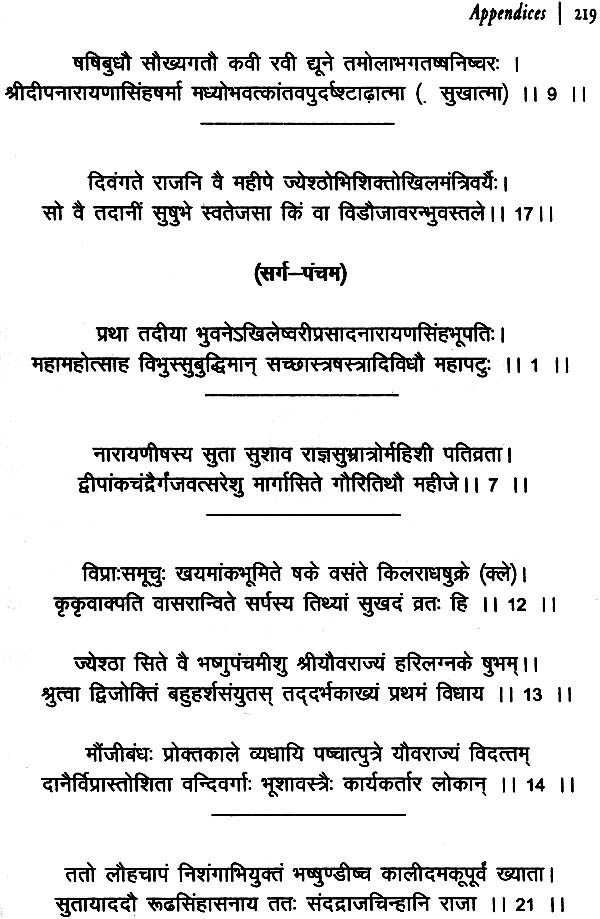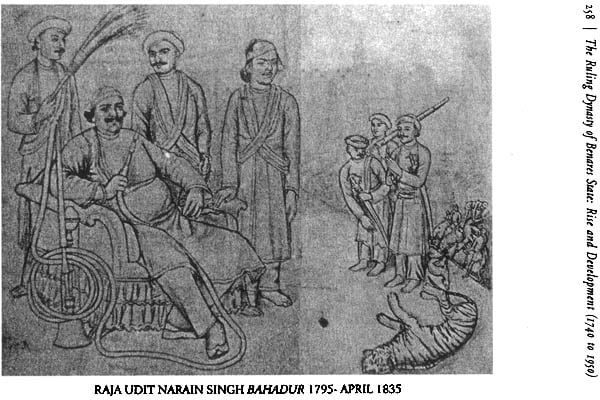
The Ruling Dynasty of Benares State (Rise and Development 1740 to 1950 A.D.)
Book Specification
| Item Code: | NAG093 |
| Author: | Shreya Pathak |
| Publisher: | Anamika Publishers & Distributor (P) Ltd. |
| Language: | English |
| Edition: | 2014 |
| ISBN: | 9788179754771 |
| Pages: | 301 |
| Cover: | Hardcover |
| Other Details | 9 inch X 5.5 inch |
| Weight | 520 gm |
Book Description
About the Book
The book is the study of the political history of the ruling dynasty of Benares, how the dynasty came into emergence after a long hiatus of seven centuries, why British had coveted eyes over the Zamindary and how they gradually encroached the political rights and influence of the rulers of Benares. Main thrust is on the rulers of Benares. Main thrust is on the rising by the people in 1781 where it proves that this rising was not an accident due to Raja's arrest and undignified treatment, but pre-meditated scheme of governor-general with an ulterior motive to disinherit raja chait Singh. Hastings had personal resentment against the raja for supporting his opposing group in the executive council. Ironically, the English who do not regard raja Benares something more than a zamindar while he was ruling as Maharaja and Benares state was created in 1911 though at that time he was having only 5 paraganas under his rule.
About the Author
Dr. Shreya Pathak completed her schooling from Methodist high school. Kanpur and st. Mary's inter college, etawah. She has done her graduation in history (hons) from Vasanta College for women, Rajghat, Banaras Hindu University in 2002 and her post graduation from Banaras Hindu University in 2004 with modern history as her field of specialization. She was awarded doctorate in 2009 from Lucknow University for which she was sanctioned junior research fellowship for three academic years from Indian council of historical pleted P.G. Diploma in public administration (gold medalist) and one year diploma in French from Lucknow University.
She is elected life member of numerous academic societies: IHCS, IAS, NSI, IHC, UPHC, HIS etc. she has actively participated and presented research papers in international and national seminars and more than ten research papers has been published in different reputed research journals. Presently, she is posted as assistant professor in Vasanta College for women Rajghat fort, Varanasi (B.H.U.) in P.G. Department of History.
Preface
The present work is my thesis submitted for the award of Doctorate degree in the Department of Medieval and Modern Indian History, University of Lucknow under the title the "Royal Dynasty of Benares: Rise and Development with Special Reference to its contribution to the Freedom Struggle of India: A Historical Study (1740 A.D. to 1950 A.D.)"
During my graduation and post-graduation studies in Banaras, as a history student, I was very inquisitive to know about the history of the Ruling Dynasty of Banaras. When I commenced my search, I found prolific writings on the religious, commercial, cultural, educational history of Banaras, but not much material was available on the history of the Ruling Dynasty. As a P.G. student I had two questions in my mind: What role did the Ruling Dynasty of Banaras played in the Indian History particularly Raja Chait Singh and how Banaras came under the administration of British. To quench my thirst, I decided to take up this topic for research.
My work has been categorized into seven chapters. Here I want to make clear one point regarding my chapterization that where on one hand, I have discussed one Raja of the Dynasty, Raja Chait Singh in three chapters, on the other hand I have discussed the reign of total six Rajas and Maharajas in the last chapter. After the death of Raja Balwant Singh, his son Raja Chait Singh succeeded him, but it was a bit controversial leading to interference into the matter of coronation by the English in spite of the fact that Benares was under the authority of Nawab Vizier Shuja-ud-daula. It was extremely apropos to the English as to who would be placed on the gaddi of Benares because zamindary was mere 60 miles beyond their boundary and a center of trade, commerce and a holy capital of Hindus. It was time when Indian political conditions were in a state of complete flux, which definitely affected the Benares zamindary and these political developments of Benares greatly affected the politics of that time. Moreover, there was a rising in Benares in 1781, which was first of its type and a matter of great concern for the English as the Governor General was in a danger of his life. So, to elucidate the political conditions and developments of Benares, its transfer from Nawab Vizier to East India Company in 1775, high-handed interference of the English and eventually, the rising of 1781, I thought it prudent to give it enough space in my work.
After 1781, the Rajas and Maharajas political rights and privileges were in the clutches of the English. In 1794-95, they were limited to Family Domains and later in 1828, the English even entered in the administration of Family Domains. The rights and privileges of the Maharaja were only of name and after 1828 his decisions were made subject to the approbation of the Superintendent of Family Domains. So the Rajas and Maharajas during later years focused more in the cultural, religious, social and educational field.
In my book, I have focused on three points. Firstly, how this Hindu Dynasty emerged on the political scene and why only Mansaram, a Hindu, was chosen as a founder of the Dynasty at a time when there was a Muslim ruler both in Oudh Suba and on Imperial throne. Secondly, the role of Raja Balwant Singh during and after the battle of Buxar has been belittled so far. I have profoundly studied the importance of Benares zamindary for the East India Company during that time, which impelled them to give the Raja a place even in the treaty of Allahabad of 1765 and adopt an amiable policy towards the Raja of Benares. Thirdly, I have profoundly discussed the events prior to the rising of 1781 and showed that how the arrest of Raja Chait Singh, one of the most popular episode during the time of Governor General Warren Hastings, was not the result of Raja's conduct or circumstances, but was a premeditated step of the Governor General actuated by his personal resentment against the Raja that eventually led to the rising.
In first chapter, I have mentioned the antiquity and history of Benares in ancient, medieval and modern times, starting from Dwapar Yuga till the third decade of the 18th century just before the foundation of the present Dynasty. This chapter reveals the circumstances that led to an emergence of a Hindu Dynasty at that time with the full approbation of Nawab Vizier and Mughal Emperor. The second chapter discusses the early political activities of Mansaram, his prominence and increasing sway in the region and eventually becoming the founder of the Dynasty. It is an analytical study of the political and economic developments of the time that made the circumstances propitious for him, giving him acceptance by the Oudh Nawab, Mughal Emperor and the people of Benares in 1738 as the Raja of Benares.
Third chapter deals with the political activities of Raja Balwant Singh since his succession in 1740 and his emergence as a real architect of the Dynasty. Description of the expansion of the Raja's sway, consolidation of power, the Raja's relations with the Nawab and the English Company before and after the battle of Buxar, his role in the battle of 1764 has been given in detail. It also mentions the increasing prominence of Benares and its Raja for the English and the ulterior motive behind the adoption of amiable policy by the East India Company towards Benares instantly after the battle on October 23, 1764. The articles of the Treaty of Allahabad of 1765 have been studied as far as it was concerned to Benares and its Raja.
Fourth chapter discusses the conditions in which Raja Chait Singh succeeded after his father's death in 1770. It discusses in detail the relations of Raja Chait Singh with the Nawab Vizier and the English Company and the Governor General's conference with the Vizier in 1773. Analytical study of the political, strategical, economical and religious factors on why and how the Benares was transferred from the Nawab Vizier to the English Company by the treaty of 1775, the revenue settlement of the Benares zamindary has been conducted with the English Company after the transfer, and the status and privileges of the Raja after the transfer of the zamindary, The deliberations of the Bengal Council, members opinion and differences regarding the transfer of Benares and its process of revenue collection and the establishment of the office of Resident have been mentioned in detail.
The fifth chapter is about the change of the policy of the Bengal Council instantly after the transfer of Benares and their high-handed interference into the administration of Raja Chait Singh through the office of the Resident of Benares. It discusses the Council's demand of subsidy and force from the Raja as his burden of the Anglo-French war, the use of the Office of Resident of Benares as an instrument for compelling the Raja to do the needful, and the Raja's reaction to these demands. The relations between Raja and Hastings and how the Raja was subjected to great humiliation that affected the political developments in ensuing years have been studied in detail.
The sixth chapter is totally devoted to the rising in the Benares zamindary in 1781. The arrest of the Raja on the orders of the Governor General, reaction of the Raja's men and the inhabitants of Benares, spread of rising in Oudh and Bihar, difficulties that the English army and the Governor General had to face during their stay at Benares city, peoples support to their Raja and finally capture of all the forts of the zamindary by the English army are important facts in this chapter. Till now in history it is known that it was Raja Chait Singh who revolted against the English with full support of the people of Benares, but I have tried to explain that how Hastings actuated by his personal resentment against the Raja, instigated him to stand against the Company. Hastings wanted to disinherit that was possible only under to pay the revenue regularly. The facts and events have been mentioned which makes it evident that Hastings had premeditated plans for the arrest of the Raja and eventually his disinheritance.
The last chapter starts with the effect of the rising and the succession by Raja Maheep Narain Singh. It's about how the English silently entered into the administration of the Raja of Benares in spite of restoring him the zamindary by the sunnud of 1781. First the treaty of 1794 made the Raja limited to his Family Domains and the administration of other regions were now in the hands of the Company. Later on by the Regulation VII of 1828 they entered into the administration of the Family Domains also by the establishment of the office of Superintendent of Family Domains. Though the Raja still enjoys some rights and privileges, but obviously with the establishment of the Office of Superintendent, many of his decisions and actions were subject to the Superintendent's approbation. I have also mentioned the Instrument of Transfer of 1911 by which Benares State was created including Bhadohi, Kara Mangroor and Ramnagar and its Raja was regarded as Maharaja and Ruling Chief of the State. After independence, the State merged into the Dominion of India as part of United Provinces by the treaty with the Government of India in September 5, 1949.
Finally the conclusion carries the views of the researcher and her analysis. One important source for the history of the dynasty is Khairuddin's Tuhfa-i-Taza alias Balwantnama in Persian. F. Curwen translated it in English in 1875, but even after making great endeavours I was unable to concern this source due to unavailability of the translated copy till the submission of my thesis. After the awad of Doctorate degree this important source was translated in English by I.H. Ansari and H.A. Qureshi in 2009 from Lucknow under title Tohfa-i-Taza of Fakhir Khairuddin and Minutes of Charges of Warren Hastings that has been consulted. My sincere thanks to both the translators. I have consulted the material from National Archives of India, New Delhi, Library of Indian Council of Historical Research, New Delhi; Library of National Museum of India, New Delhi; U.P. State Archives, Lucknow; Regional Archives, Varanasi; Regional Archives, Allahabad; Kashi Raj Nyas Trust, Ramnagar Fort; Shayaji Gaekwad Central Library, Banaras Hindu University; Bharat Kala Bhawan, Banaras Hindu University; Library of Advance Center of History, Aligarh Muslim University; Central Library, Aligarh Muslim University, Central Library, Allahabad University and Saraswati Bhavan Central library of Sampooranand Sanskrit Vishwavidhyalay.
In presenting my work, first of all I am highly grateful to the Almighty without whose blessed hands I would have never succeeded in accomplishing my work. I am greatly indebted to my father Mr. Shridhar Pathak, Indian Police Service and my mother Mrs. Shashi Pathak, who gave their unstinting support and strengthen my motives whenever, I felt blue. The support and courage given by them cannot be put into words. I am thankful to my sister Dr. Shalini Pathak for encouragement, valuable suggestions and help that she gave me from time to time.
I owe my deep gratitude and obligation to my supervisor, Prof. A.K Misra, for giving his precious time and for discussing the topic with me in 'detail. I am highly thankful to Dr. Kunwar Anant Narain Singh Bahadur, Maharaja of Banaras and Kashi Raj Nyas Trust for allowing me to enter the museum and access the library of the fort of Ramnagar and take of notes of material provided. I am also grateful to the staff of President House, India for providing me information regarding the army of Raja Chait Singh, which later became the nucleus of President's Body Guard. I owe my deep gratitude and pay my sincere thanks to the Indian Council of Historical Research for sanctioning me the Junior Research Fellowship for my research work. I owe my special thanks to the Managers and Staff of different institutes and libraries that I have consulted during my research.
My sincere thanks to Mr. Pankaj Sharma, Anamika Publishers and Distributors (P) Ltd. and his staff for publishing this work.
Contents
| Preface | ix | |
| List of Abbreviations | xv | |
| 1 | Historical background | 1 |
| 2 | Mansaram: The founder of the Ruling Dynasty of Benares | 20 |
| 3 | Raja Balwant Singh: Strategies for Expansion and consolidation | 32 |
| 4 | Raja Chait Singh: Transfer of Benares to east India company | 60 |
| 5 | Increasing tribulations of Raja Chait Singh: Interference of the Bengal council into Benares | 92 |
| 6 | The People's rising in Benares against the English power | 128 |
| 7 | Benares from Raja Maheep Narain to the merger into the dominion of India | 158 |
| Conclusions | 193 | |
| Appendices | 209 | |
| Bibliography | 269 | |
| Index | 283 |

